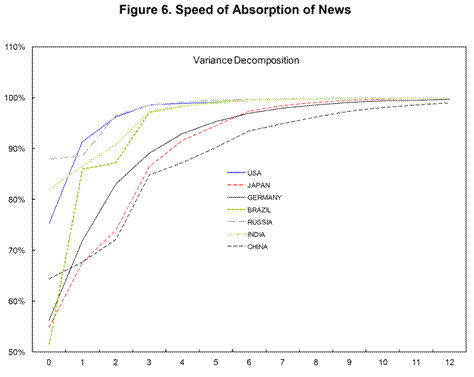From a new IMF working paper by Prakash Loungani:
We document information rigidity in forecasts for real GDP growth in 46 countries over the past two decades….
We investigate: (i) if rigidities are lower around turning points in the economy, such as in times of recessions and crises; (ii) if rigidities differ across countries, particularly between advanced countries and emerging markets; and (iii) how quickly forecasters incorporate news about growth in other countries into their growth forecasts, with a focus on how advanced countries’ growth forecasts incorporate news about emerging market growth and vice versa.
Figure 6 from the paper shows how fast news is incorporated.

Figure 6 from Loungani (2011).
More on informational rigidities by Coibion and Gorodnichenko (2009, 2010), and Gorodnichenko (2010).
This is a terribly written paper.
If you are an economist, and you begin you paper with “This paper studies…”, you’re doomed from the outset. Stylistically and structurally, this leads nowhere.
Why did the authors do this study? What’s the problem they’re trying to address? I can’t really tell.
So here might be a theoretical first sentence to help the reader:
“The IMF provides GDP forecasts used by national decision-makers, economists and private sector analysts throughout the world. Indeed, the Fund is the premier source for such data, and therefore its strives to deliver forecasts of the highest quality. In forming its expectations for economic growth, the IMF takes into consideration the view of other macroeconomic analysts. Understanding the degree to which these take into account recent developments is helpful, in fact, necessary to enable the IMF to maximize the accuracy of its own forecasts.”
Is this the purpose of the paper? I’m not sure. If it is, then this is a niche paper concerning the sizing of error bars around forecasts or about adjusting forecasts to account for lack of updating by third party analysts. Nothing wrong with that, but then it’s really a narrow focus paper.
So: Once again we see a producer (or technology)-oriented, not consumer (or market)-oriented, paper. “This paper studies” has no audience. It is the authors telling the world what they’re doing, with no regard for the value of the reader’s time, effort or degree of interest.
But this problem is easily solved, if the intent exists to do so.
A little off topic but still concerning growth Austan Goolsbee is leaving the Obama administration. Often serious economists are eaten up by the political system. That happened early in the Reagan administration as supply siders saw their policies torn to pieces by a combination of monetarist demand side ideologues and political opportunists.
I do not agree economically with Austan Goolsbee but I believe the man is an honest economist. I wish him well and agree that he is doing the right thing. This administration has taken down many serious thinkers while elevating ideologues and political opportunists.
let me translate into english.
forecasters are sticky
1)and dont pass news 100% at first or
2)are crowd followers.
so you can know abolutely nothing about something.
take the latest concensus forecast
add or subtract a tenth or two from its recent up or down trend the last several months
and have a decent forecast thats better than concensus
I learned something unexpected. Reading the paper they talked about a 7 country VAR. The first thing that popped into my head was to ask if the ordering of the countries would affect their results. Seems kind of obvious that it might. But the authors answered that with a reference to a GIRF procedure that mutes the VAR ordering problem. That was news to me. I wasn’t aware of that approach. Thanks.
Menzie…any comments on their ordering-free approach?
AWH Your suggestion is an excellent one. I have used this technique amongst many others over the years. There is information to be exploited in the first and second derivative which you so correctly point out though not putting it in these exact terms. Of course the difficulty comes at turning points, at which time some independent vector(s) needs to be called in, and then for a time your suggested technique given a rest. But for the expansion proper, and for the final year of the expansion, you have succinctly described a valuable tool that is not usually talked about and that is also easy to compute. In ways like this you can over the long haul outperform the consensus, though never with absolute assurance in any given quarter.